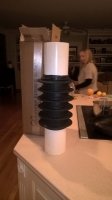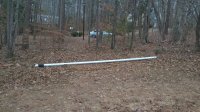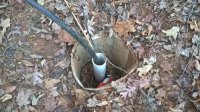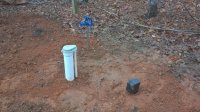crazyjncsu
New Member
I'm building a house, kind of high-end, and dealing with the builders, county, everyone gets _really_ expensive when I leave things to them. But I've done about $100,000 worth of site work myself, and this stuff has so far flew totally under the radar (I've done it right) and been a great savings to us. I'm wondering if dealing with my well would be best to do myself.
I'd like to eventually use the well for drinking water, but that will be over a year from now. Until then, I'll be using it for irrigation.
The well seems to produce plenty of flow. With a pump at ~80ft, I have pumped 10gpm for hours at a time during some pretty dry weather (NC over past few months) without any indication it's running dry.
The well head is below grade.
The well has no markings for GPM, depth, or anything.
It started out pumping really muddy water, but cleared up after running for a while.
An old-timer grading contractor was really curious and talked with me a good bit about the well. He seemed to be convinced the mud just came from it being below grade, and there wasn't much likelihood of there being an issue with how the casing was grouted into bedrock.
The pump still hits mud at maybe 80-90ft. I think I should get this mud out for both the reason of getting the pump deeper and just to get the mud out of the system.
I measure water maybe 15ft from the surface. Once the water drops maybe 10ft from there, I can hear water trickling into the well.
Seems I can extend it with a Dresser coupling with a kit like this: http://www.completeplumbingsource.com/od-pvc-well-casing-extension-kit ... Would this be a good idea to install myself?
And for cleaning the well... I have a pond 125 ft from the well. I have a 2" water pump already setup for irrigation. It pumps ~10,000gph=~166gpm=~10cfm. I already have 150ft of 2" discharge hose with an adjustable fire nozzle on the end. I'd need to buy about $100 more of discharge hose to reach the bottom of the well. Will forcing a bunch of pond water in the bottom of the well fix my issue? I figure it'll get the mud out but not much sand or gravel. Will this likely be productive and worth a couple hours of effort? Or should I rent a 200cfm compressor?
Or should I be leaving all of this to the pros?
Thanks!
I'd like to eventually use the well for drinking water, but that will be over a year from now. Until then, I'll be using it for irrigation.
The well seems to produce plenty of flow. With a pump at ~80ft, I have pumped 10gpm for hours at a time during some pretty dry weather (NC over past few months) without any indication it's running dry.
The well head is below grade.
The well has no markings for GPM, depth, or anything.
It started out pumping really muddy water, but cleared up after running for a while.
An old-timer grading contractor was really curious and talked with me a good bit about the well. He seemed to be convinced the mud just came from it being below grade, and there wasn't much likelihood of there being an issue with how the casing was grouted into bedrock.
The pump still hits mud at maybe 80-90ft. I think I should get this mud out for both the reason of getting the pump deeper and just to get the mud out of the system.
I measure water maybe 15ft from the surface. Once the water drops maybe 10ft from there, I can hear water trickling into the well.
Seems I can extend it with a Dresser coupling with a kit like this: http://www.completeplumbingsource.com/od-pvc-well-casing-extension-kit ... Would this be a good idea to install myself?
And for cleaning the well... I have a pond 125 ft from the well. I have a 2" water pump already setup for irrigation. It pumps ~10,000gph=~166gpm=~10cfm. I already have 150ft of 2" discharge hose with an adjustable fire nozzle on the end. I'd need to buy about $100 more of discharge hose to reach the bottom of the well. Will forcing a bunch of pond water in the bottom of the well fix my issue? I figure it'll get the mud out but not much sand or gravel. Will this likely be productive and worth a couple hours of effort? Or should I rent a 200cfm compressor?
Or should I be leaving all of this to the pros?
Thanks!




